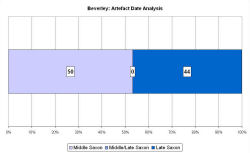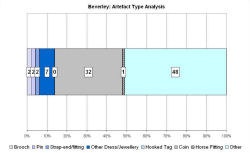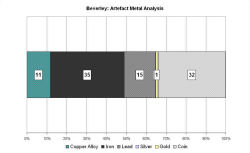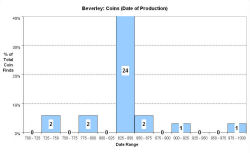Fingerprint charts for i) artefact date analysis, ii) artefact type analysis, iii) artefact metal analysis and iv) coins – date of production




References: Armstrong et al. 1991; Pirie 1991
Archives:
http://ads.ahds.ac.uk/catalogue/search/fr.cfm?rcn=EHNMR-657952
Excavations at Lurk Lane, Beverley, between 1979 and 1982, on a site c. 20m from the south side of the Minster church revealed a continuous sequence of occupation from the 8th to the 19th century. Middle Saxon deposits comprised a sequence of ditches, with an associated bank, cobbled surface and a possible structure, which may have been a smithy. Traces of a possible fish weir were also recovered. A small purse-hoard of 23 stycas was found in a small hole dug into the bank (Pirie 1991). The assemblage also included relatively large quantities of faunal remains, metalworking evidence, metalwork, stone artefacts, York Ware and Ipswich Ware pottery and coinage. The VASLE dataset is derived from the published excavation report.
The site was interpreted by the excavators as the location of the monastery of Inderauuda 'in the wood of the men of Deira', where Bede says John of Hexham was buried in AD 721. Environmental evidence indicated nearby woodland, but this is not conclusive. The dating of the Middle Saxon phase is very broad and although there is a hiatus in activity in the late 9th century, when the monastery suffered Viking attack, this would also be true of lots of places. The ditch was interpreted as a vallum monasterii on the grounds that it was too substantial to be a field boundary, but Loveluck (1998, 158-9) has pointed out that a range of settlements had boundary ditches. Despite its location next to the Minster, the identification of Lurk Lane as the monastery of Inderauuda would appear to be insecure and a secular rural settlement, possibly of high status given the finds assemblage, would seem equally likely (Naylor 2004, 31).
Fingerprint charts for i) artefact date analysis, ii) artefact type analysis, iii) artefact metal analysis and iv) coins – date of production




© Internet Archaeology/Author(s)
URL: http://intarch.ac.uk/journal/issue25/2/4.4.6.html
Last updated: Tues Apr 21 2009